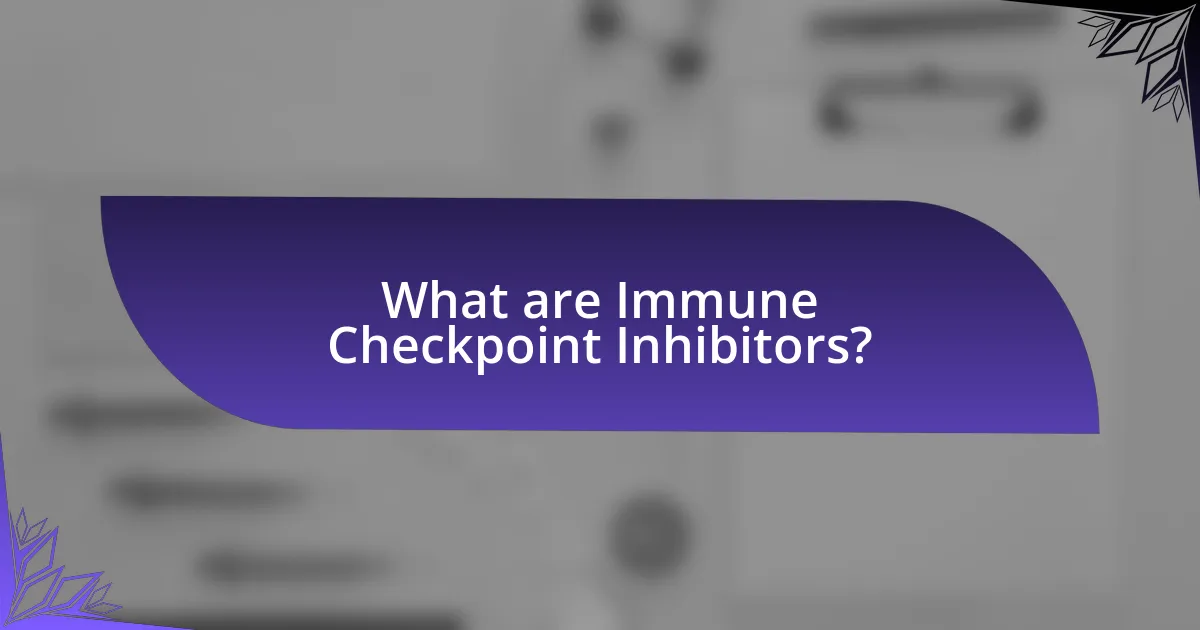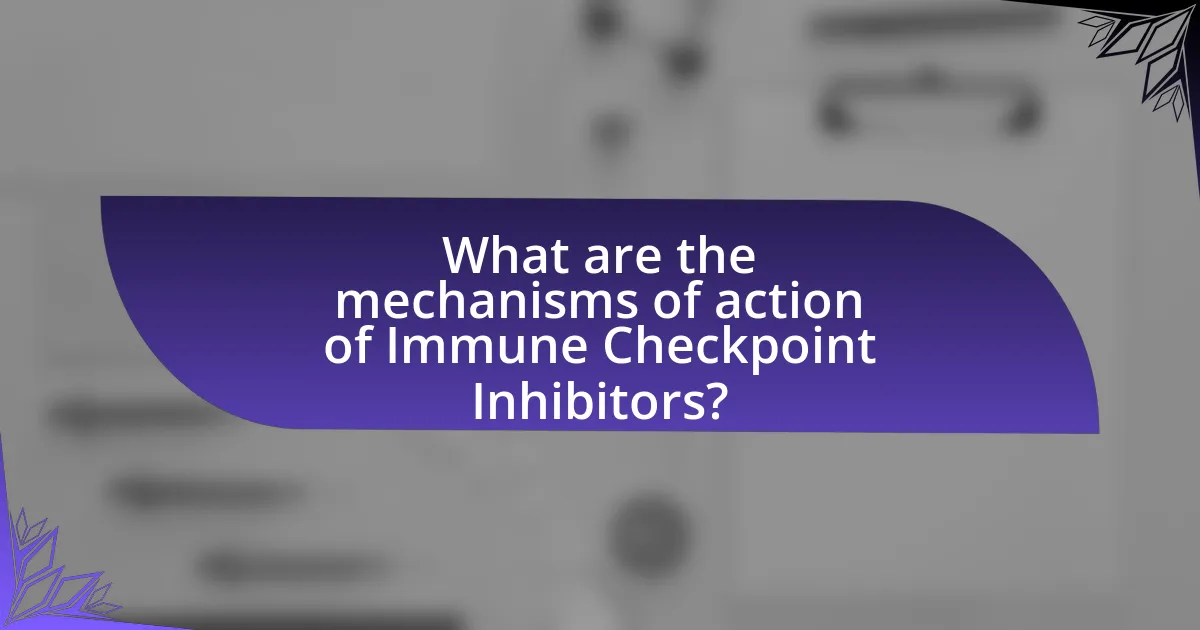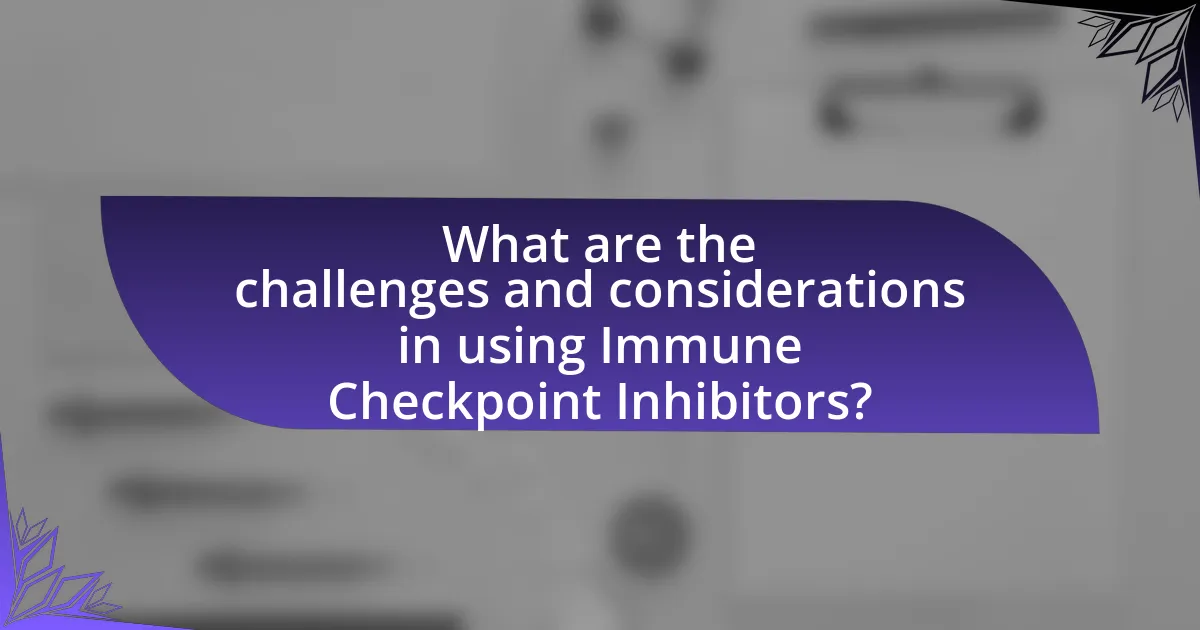Immune checkpoint inhibitors are a class of cancer therapies that enhance the immune system’s ability to target and destroy tumor cells by blocking specific proteins, such as PD-1, PD-L1, and CTLA-4, which cancer cells use to evade immune detection. This article provides a comprehensive overview of how these inhibitors function, the key immune checkpoints they target, and their significance in cancer treatment, including the types of cancers they effectively treat. It also addresses the mechanisms of action, challenges associated with their use, common side effects, and the biological factors contributing to resistance. Furthermore, the article explores future research directions and best practices for optimizing the use of immune checkpoint inhibitors in clinical settings.

What are Immune Checkpoint Inhibitors?
Immune checkpoint inhibitors are a class of drugs that enhance the immune system’s ability to fight cancer by blocking proteins that inhibit immune responses. These inhibitors target specific checkpoints, such as PD-1, PD-L1, and CTLA-4, which cancer cells exploit to evade immune detection. By inhibiting these checkpoints, immune checkpoint inhibitors can restore T-cell activity against tumors, leading to improved anti-tumor responses. Clinical studies have demonstrated their effectiveness in treating various cancers, including melanoma and lung cancer, with significant survival benefits observed in patients receiving these therapies.
How do Immune Checkpoint Inhibitors function in the immune system?
Immune checkpoint inhibitors function by blocking proteins that inhibit immune responses, thereby enhancing the immune system’s ability to attack cancer cells. These inhibitors target specific checkpoints, such as PD-1, PD-L1, and CTLA-4, which are mechanisms that tumors exploit to evade immune detection. By inhibiting these checkpoints, immune checkpoint inhibitors restore T-cell activation and proliferation, allowing the immune system to recognize and destroy cancer cells more effectively. Clinical studies have demonstrated that therapies like pembrolizumab and nivolumab, which target PD-1, have led to significant tumor regression in various cancers, validating their role in cancer immunotherapy.
What are the key immune checkpoints targeted by these inhibitors?
The key immune checkpoints targeted by immune checkpoint inhibitors are CTLA-4, PD-1, and PD-L1. CTLA-4 (Cytotoxic T-Lymphocyte Antigen 4) is primarily involved in the early phase of T-cell activation, while PD-1 (Programmed Cell Death Protein 1) and PD-L1 (Programmed Death-Ligand 1) play crucial roles in the later stages of T-cell response, particularly in the tumor microenvironment. These checkpoints are critical for regulating immune responses, and their inhibition has been shown to enhance anti-tumor immunity, leading to improved outcomes in various cancers, as evidenced by the success of therapies like ipilimumab (targeting CTLA-4) and pembrolizumab (targeting PD-1).
How do these checkpoints regulate immune responses?
Immune checkpoints regulate immune responses by acting as inhibitory signals that prevent T cells from becoming overly activated. These checkpoints, such as CTLA-4 and PD-1, bind to their respective ligands on antigen-presenting cells or tumor cells, leading to a decrease in T cell proliferation and cytokine production. This mechanism is crucial for maintaining self-tolerance and preventing autoimmunity, as evidenced by studies showing that blocking these checkpoints can enhance anti-tumor immunity, as demonstrated in clinical trials with immune checkpoint inhibitors like pembrolizumab and ipilimumab.
Why are Immune Checkpoint Inhibitors important in cancer therapy?
Immune checkpoint inhibitors are important in cancer therapy because they enhance the body’s immune response against tumors. These therapies work by blocking proteins that inhibit immune cells, allowing T-cells to recognize and attack cancer cells more effectively. Clinical studies have shown that immune checkpoint inhibitors, such as pembrolizumab and nivolumab, have led to significant improvements in survival rates for various cancers, including melanoma and non-small cell lung cancer. For instance, a study published in the New England Journal of Medicine demonstrated that nivolumab improved overall survival in patients with advanced melanoma compared to traditional therapies. This evidence underscores the critical role of immune checkpoint inhibitors in modern cancer treatment strategies.
What types of cancers are treated with Immune Checkpoint Inhibitors?
Immune checkpoint inhibitors are primarily used to treat melanoma, non-small cell lung cancer, renal cell carcinoma, bladder cancer, head and neck squamous cell carcinoma, and Hodgkin lymphoma. These cancers have shown significant responsiveness to therapies that target immune checkpoints, such as PD-1, PD-L1, and CTLA-4, which enhance the immune system’s ability to recognize and attack cancer cells. For instance, the use of pembrolizumab and nivolumab in melanoma has led to improved survival rates, demonstrating the effectiveness of immune checkpoint inhibition in these specific cancer types.
How do these inhibitors enhance anti-tumor immunity?
Immune checkpoint inhibitors enhance anti-tumor immunity by blocking proteins that inhibit T-cell activation, thereby allowing the immune system to recognize and attack cancer cells more effectively. For instance, inhibitors targeting PD-1 or CTLA-4 pathways release the brakes on T-cells, promoting their proliferation and activity against tumors. Clinical studies have shown that patients treated with these inhibitors often experience improved survival rates and tumor regression, demonstrating their efficacy in mobilizing the immune response against malignancies.

What are the mechanisms of action of Immune Checkpoint Inhibitors?
Immune checkpoint inhibitors function by blocking proteins that inhibit immune responses, thereby enhancing the body’s ability to recognize and attack cancer cells. These inhibitors target specific checkpoints, such as CTLA-4 and PD-1/PD-L1, which are regulatory pathways that tumors exploit to evade immune detection. For instance, CTLA-4 inhibits T-cell activation, while PD-1/PD-L1 interactions suppress T-cell responses in the tumor microenvironment. By inhibiting these pathways, immune checkpoint inhibitors restore T-cell activity, leading to increased anti-tumor immunity and improved clinical outcomes in various cancers, as evidenced by significant survival benefits observed in clinical trials.
How do Immune Checkpoint Inhibitors block inhibitory signals?
Immune checkpoint inhibitors block inhibitory signals by targeting specific proteins on immune cells or tumor cells that regulate immune responses. These inhibitors, such as anti-PD-1 and anti-CTLA-4 antibodies, bind to their respective checkpoints, preventing the interaction between these proteins and their ligands. This blockade enhances T-cell activation and proliferation, allowing the immune system to recognize and attack cancer cells more effectively. Studies have shown that the use of these inhibitors can lead to significant tumor regression in various cancers, demonstrating their role in overcoming immune evasion mechanisms employed by tumors.
What role do PD-1 and CTLA-4 play in immune regulation?
PD-1 and CTLA-4 are critical immune checkpoint proteins that regulate T-cell activation and tolerance. PD-1, expressed on activated T-cells, inhibits their function upon binding to its ligands, PD-L1 and PD-L2, which are often upregulated in tumors, leading to immune evasion. CTLA-4, on the other hand, competes with the co-stimulatory receptor CD28 for binding to B7 molecules on antigen-presenting cells, thereby downregulating T-cell activation. Both PD-1 and CTLA-4 serve as negative regulators of immune responses, maintaining self-tolerance and preventing autoimmunity, while also being exploited by tumors to escape immune surveillance.
How does blocking these signals lead to T-cell activation?
Blocking inhibitory signals, such as those from immune checkpoint proteins like PD-1 and CTLA-4, enhances T-cell activation by removing the brakes on T-cell responses. When these inhibitory signals are blocked, T-cells can proliferate and produce cytokines more effectively, leading to a stronger immune response against tumors or pathogens. Research has shown that immune checkpoint inhibitors can significantly improve T-cell activity, as evidenced by clinical trials demonstrating increased tumor regression in patients treated with these agents.
What are the downstream effects of T-cell activation?
The downstream effects of T-cell activation include the proliferation of T-cells, the production of cytokines, and the differentiation into effector and memory T-cells. Upon activation, T-cells undergo clonal expansion, leading to an increase in their numbers, which enhances the immune response. Additionally, activated T-cells secrete various cytokines such as interleukin-2 (IL-2), which further stimulates T-cell growth and activates other immune cells. This process is crucial for establishing long-term immunity, as some T-cells differentiate into memory T-cells that provide a faster response upon re-exposure to the same antigen. These effects are essential for effective immune surveillance and the elimination of pathogens or tumor cells.
How do activated T-cells recognize and attack cancer cells?
Activated T-cells recognize and attack cancer cells primarily through the identification of specific antigens presented on the surface of these cells. Cancer cells often express abnormal proteins or mutated forms of normal proteins, known as tumor-associated antigens, which are displayed on major histocompatibility complex (MHC) molecules. When T-cell receptors (TCRs) on activated T-cells bind to these antigens, it triggers a cascade of immune responses, including the release of cytotoxic molecules that induce apoptosis in the cancer cells. This process is supported by the interaction of co-stimulatory signals, such as CD28 binding to CD80/CD86 on antigen-presenting cells, which enhances T-cell activation and proliferation. Studies have shown that the effectiveness of T-cell responses against tumors can be significantly influenced by the presence of immune checkpoint proteins, such as PD-1 and CTLA-4, which can inhibit T-cell activity when engaged, thus highlighting the importance of immune checkpoint inhibitors in cancer therapy.
What is the significance of cytokine release in this process?
Cytokine release is significant in the context of immune checkpoint inhibitors as it plays a crucial role in modulating the immune response against tumors. The release of cytokines, such as interferons and interleukins, enhances the activation and proliferation of immune cells, particularly T cells, which are essential for targeting and destroying cancer cells. Studies have shown that increased levels of cytokines correlate with improved therapeutic outcomes in patients receiving immune checkpoint inhibitors, indicating that effective cytokine signaling can lead to a more robust anti-tumor immune response.

What are the challenges and considerations in using Immune Checkpoint Inhibitors?
The challenges and considerations in using Immune Checkpoint Inhibitors include immune-related adverse events, patient selection, and the variability in response rates. Immune-related adverse events can affect multiple organ systems, leading to conditions such as colitis, pneumonitis, and endocrinopathies, which require careful monitoring and management. Patient selection is critical, as not all patients respond to these therapies; biomarkers like PD-L1 expression and tumor mutational burden are often used to identify likely responders. Additionally, the variability in response rates can be significant, with some patients experiencing durable responses while others may not benefit at all, highlighting the need for ongoing research to better understand the mechanisms of action and resistance.
What are the common side effects associated with Immune Checkpoint Inhibitors?
Common side effects associated with Immune Checkpoint Inhibitors include fatigue, rash, diarrhea, and immune-related adverse events affecting organs such as the lungs, liver, and endocrine glands. These side effects occur due to the activation of the immune system, which can lead to inflammation in various body parts. Clinical studies have shown that approximately 60% of patients experience some form of immune-related adverse event, with 10-20% requiring corticosteroid treatment to manage these effects.
How can these side effects impact patient quality of life?
Side effects from immune checkpoint inhibitors can significantly diminish patient quality of life by causing physical discomfort, emotional distress, and functional impairment. For instance, common side effects such as fatigue, skin rashes, and gastrointestinal issues can lead to decreased daily functioning and increased reliance on caregivers. Research indicates that patients experiencing severe side effects report lower health-related quality of life scores, highlighting the correlation between adverse effects and overall well-being. Additionally, psychological impacts, including anxiety and depression, can arise from the unpredictability of side effects, further compromising patients’ quality of life.
What strategies are used to manage these side effects?
Strategies used to manage side effects of immune checkpoint inhibitors include the use of corticosteroids, immunosuppressants, and supportive care measures. Corticosteroids are often employed to reduce inflammation and immune responses that lead to adverse effects, such as colitis or pneumonitis. Immunosuppressants may be utilized in more severe cases to mitigate autoimmune reactions. Supportive care measures, including symptom management and patient education, are also critical in addressing side effects effectively. These strategies are supported by clinical guidelines and studies demonstrating their efficacy in managing immune-related adverse events associated with these therapies.
How do resistance mechanisms affect the efficacy of Immune Checkpoint Inhibitors?
Resistance mechanisms significantly reduce the efficacy of Immune Checkpoint Inhibitors (ICIs) by enabling tumor cells to evade immune detection and destruction. These mechanisms include alterations in the tumor microenvironment, such as increased immunosuppressive cell populations, and genetic changes in tumor cells that affect antigen presentation or the expression of checkpoint molecules. For instance, loss of major histocompatibility complex (MHC) class I expression on tumor cells can prevent recognition by cytotoxic T cells, thereby diminishing the effectiveness of ICIs that target checkpoints like PD-1 or CTLA-4. Studies have shown that approximately 40% of patients with melanoma exhibit resistance to ICIs due to such mechanisms, highlighting the need for combination therapies to overcome these barriers.
What are the biological factors contributing to resistance?
Biological factors contributing to resistance in immune checkpoint inhibitors include genetic mutations, tumor microenvironment characteristics, and immune system evasion mechanisms. Genetic mutations, such as alterations in the genes encoding for PD-L1 or CTLA-4, can lead to reduced efficacy of these therapies. The tumor microenvironment may harbor immunosuppressive cells, such as regulatory T cells and myeloid-derived suppressor cells, which inhibit effective immune responses. Additionally, tumors can exploit various pathways to evade immune detection, including the upregulation of alternative immune checkpoints and the secretion of immunosuppressive cytokines. These factors collectively diminish the therapeutic impact of immune checkpoint inhibitors, as evidenced by studies showing that tumors with high mutational burden often respond better to these treatments, while those with specific immune evasion strategies exhibit resistance.
How can understanding resistance lead to improved treatment strategies?
Understanding resistance to immune checkpoint inhibitors can lead to improved treatment strategies by identifying specific mechanisms that tumors use to evade immune responses. For instance, research has shown that tumors may upregulate alternative immune checkpoints or downregulate antigen presentation, which can diminish the effectiveness of these therapies. By comprehensively analyzing these resistance mechanisms, clinicians can tailor treatment regimens, such as combining immune checkpoint inhibitors with other therapies like targeted agents or vaccines, to enhance patient outcomes. Studies have demonstrated that such combination therapies can overcome resistance and improve overall survival rates in patients with various cancers, highlighting the importance of understanding resistance in developing effective treatment strategies.
What are the future directions for research on Immune Checkpoint Inhibitors?
Future research on Immune Checkpoint Inhibitors (ICIs) will focus on enhancing their efficacy and expanding their applications in various cancers. Key directions include investigating combination therapies that pair ICIs with targeted therapies or other immunotherapies to overcome resistance mechanisms. Studies are also expected to explore biomarkers for patient selection, improving the identification of individuals most likely to benefit from ICIs. Additionally, research will delve into the understanding of the tumor microenvironment’s role in ICI response, aiming to develop strategies that can modulate this environment to enhance treatment outcomes. These directions are supported by ongoing clinical trials and emerging data that highlight the potential for improved patient stratification and therapeutic combinations.
How might combination therapies enhance treatment outcomes?
Combination therapies enhance treatment outcomes by targeting multiple pathways involved in disease progression, thereby increasing the likelihood of therapeutic efficacy. For instance, in cancer treatment, combining immune checkpoint inhibitors with other modalities, such as chemotherapy or targeted therapies, can lead to synergistic effects that improve overall response rates. Research has shown that the combination of nivolumab and ipilimumab, both immune checkpoint inhibitors, resulted in higher overall survival rates in melanoma patients compared to monotherapy, demonstrating the potential of combination strategies to overcome resistance mechanisms and enhance immune activation.
What novel targets are being explored in ongoing research?
Ongoing research is exploring novel targets such as LAG-3 (Lymphocyte Activation Gene 3), TIGIT (T cell immunoreceptor with Ig and ITIM domains), and VISTA (V-domain Ig suppressor of T cell activation) in the context of immune checkpoint inhibitors. These targets are being investigated for their potential to enhance anti-tumor immunity and improve therapeutic outcomes in cancer treatment. For instance, studies have shown that blocking LAG-3 can enhance T cell activation and proliferation, while targeting TIGIT may reverse T cell exhaustion, thereby increasing the efficacy of existing therapies.
What best practices should be followed when using Immune Checkpoint Inhibitors?
Best practices when using Immune Checkpoint Inhibitors include careful patient selection, monitoring for immune-related adverse events, and adherence to dosing schedules. Patient selection should involve assessing biomarkers such as PD-L1 expression and tumor mutational burden, which can predict response to therapy. Monitoring for immune-related adverse events is crucial, as these can occur in various organ systems and may require prompt intervention; studies indicate that early recognition and management of these events can improve patient outcomes. Adhering to dosing schedules ensures optimal therapeutic efficacy, as deviations can impact treatment success.



